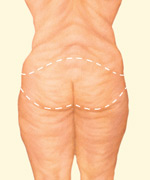Body Procedures
What is a Body Lift?

Aging, sun damage, pregnancy, significant fluctuations in weight, and genetic factors may contribute to poor tissue elasticity that can result in sagging of the abdomen, buttocks and thighs.
A body lift improves the shape and tone of the underlying tissue that supports fat and skin. Excess sagging fat and skin are removed and the procedure(s) can improve a dimpled, irregular skin surface, which is commonly known as cellulite. A body lift may include these areas:
- Abdominal area – locally or extending around the sides and into the lower back area
- Buttocks that may be low, flat or shaped unevenly
- Groin that may sag into inner thigh
- Thigh – the inner, outer, or posterior thigh, or the thigh’s circumference
Body lifts are not intended strictly for the removal of excess fat. Liposuction alone can remove excess fat deposits where skin has good elasticity and is able to naturally conform to new body contours. In cases where skin elasticity is poor, a combination of liposuction and body lift techniques may be recommended.
In general, candidates for a body lift include:
- Individuals with significant soft tissue looseness in one or multiple body areas
- Healthy individuals without medical conditions that impair healing or increase risk of surgery
- Individuals with a positive outlook and realistic goals for what body lift surgery can accomplish
- Non-smokers
- Individuals committed to leading a healthy lifestyle with proper nutrition and fitness
Consultation and Preparing for Surgery
During your consultation be prepared to discuss:
- Your surgical goals
- Medical conditions, drug allergies, and previous medical treatments
- Current medications, vitamins, herbal supplements, alcohol, tobacco, and drug use
- Previous surgeries
Your surgeon will also:
- Evaluate your general health status and any pre-existing health conditions or risk factors
- Examine and measure your body, this may include detailed body measurements
- Take photographs
- Discuss your body lift options
- Recommend a course of treatment
- Discuss likely outcomes of body lift surgery and any risks or potential complications
Prior to surgery, you may be asked to:
- Get a lab test or a medical evaluation
- Take certain medications or adjust your current medications
- Stop smoking
- Avoid taking aspirin, anti-inflammatory drugs, and herbal supplements as they can increase bleeding
Body lift surgery may be performed in an accredited office-based surgical facility, ambulatory surgical center, or a hospital.
Be sure to ask questions. It’s very important to ask your plastic surgeon questions about your body lift procedure. It’s natural to feel some anxiety, whether it’s excitement for your anticipated new look or a bit of preoperative stress. Don’t be shy about discussing these feelings with your plastic surgeon.
The Procedure
Body lifts are surgical procedures and they require extensive incisions. Incision length and pattern depend on the amount and location of excess skin to be removed, as well as surgical judgment. Advanced techniques usually allow incisions to be placed in strategic locations where they can be hidden by most types of clothing and swimsuits.
One common technique of complete lower body lift uses incisions similar to a bikini pattern to tighten the abdomen, groin, waist, thigh, and buttock in one procedure. An incision around the circumference of the body removes an apron of excess skin and fat while repositioning and tightening tissues. A combination of liposuction and surgical body lifts may be necessary to achieve an improved contour. Deep support sutures within underlying tissues help to form the newly shaped contours. Sutures, skin adhesives, tapes, or clips close the skin incisions.
Step 1 – Anesthesia
Medications are administered for your comfort during the surgical procedure. The choices include intravenous sedation and general anesthesia. Your doctor will recommend the best choice for you.
Step 2 – The incision
A complete lower body lift treats the buttocks, abdomen, waist, hips and thighs in one procedure. A circumferential incision around the body removes an apron of excess skin and fat and repositions and tightens tissues.


Step 3 – Closing the incisions
Sutures, skin adhesives or tapes close the skin incisions.


Step 4 – See the results
The results of a body lift are visible almost immediately. It may take as long as one to two years for the final results to fully develop.
Risks and Safety

The decision to have a body lift is extremely personal. You will have to decide if the benefits will achieve your goals and if the risks and potential complications are acceptable. Your plastic surgeon and/or staff will explain in detail the risks associated with surgery. You will be asked to sign consent forms to ensure that you fully understand the procedure you will undergo and any risks or potential complications.
Possible risks of body lift surgery include:
- Anesthesia risks
- Bleeding (hematoma)
- Infection
- Poor wound healing
- Fluid accumulation (blood or serum)
- Numbness or other changes in skin sensation
- Fatty tissue found deep in the skin might die (fat necrosis)
- Pain, which may persist
- Recurrent looseness of skin
- Persistent swelling in the legs
- Asymmetries
- Deep vein thrombosis, cardiac and pulmonary complications
- Possible need for revisional surgery
- Skin loss
- Sutures may spontaneously surface through the skin, become visible or produce irritation and require removal
- Unfavorable scarring
These risks and others will be fully discussed prior to your consent. It is important that you address all your questions directly with your plastic surgeon.
Recovery After Surgery
After your body lift procedure is completed, dressings or bandages will be applied to the incisions. Small, thin tubes may be temporarily placed under the skin to drain any excess blood that may collect.
You will be given specific instructions that may include how to care for your surgical site(s) following surgery, medications to apply or take orally to aid healing and reduce the risk of infection, specific concerns to look for at the surgical site or in your general health, how to care for your drains, and when to follow up with your plastic surgeon.
Be sure to ask your plastic surgeon specific questions about what you can expect during your individual recovery period.
- Where will I be taken after my surgery is complete?
- What medication will I be given or prescribed after surgery?
- Will I have dressings/bandages after surgery? When will they be removed?
- How should I bathe after surgery?
- Are stitches removed? When?
- When will the drains be removed?
- When can I resume normal activity and exercise?
- When do I return for follow-up care?
When you go home:
If you experience shortness of breath, chest pains, or unusual heart beats, seek medical attention immediately. Should any of these complications occur, you may require hospitalization and additional treatment.
Results

The results of a body lift are visible almost immediately. However, it may take two years or more for the final results of the body lift procedures to fully develop. Some visible scars will remain, but the overall results are long lasting, provided that you maintain a stable weight and general fitness. As your body ages, it is natural to lose some firmness. However, most of your initial improvement should be relatively permanent.
Although good results are expected from your procedure, there is no guarantee. In some situations, it may not be possible to achieve optimal results with a single surgical procedure and another surgery may be necessary.
Following your physician’s instructions is essential to the success of your surgery. It is important that the surgical incisions are not subjected to excessive force, swelling, abrasion, or motion during the time of healing. Your doctor will give you specific instructions on how to care for yourself.
Prices for a body lift can vary. A surgeon’s cost may be based on his or her experience, the type of procedure(s) used, and geographic office location. Many plastic surgeons offer patient financing plans, so be sure to ask.
Cost may include:
- Anesthesia fees
- Hospital or surgical facility costs
- Medical tests
- Post-surgery garments
- Prescriptions for medication
- Surgeon’s fee
Most health insurance does not cover cosmetic surgery or its complications.
